|
Label |
Label Description |
Images |
|
Tabansi |
Dating to post-WWII (I would guess), this was made by EMI for
export to Nigeria.
Thanks to Richard Prout for the label image. |
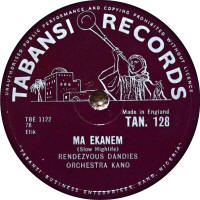 |
|
Tailgate |
A post-WWII label produced by the Sheffield Jazz Club devoted to
British Trad. Jazz bands. Tailgate records first appeared in late 1949,
pressed in vinyl and were available from the club at 159, Alnwick Road,
Sheffield and also from the International Book Club of London. They cost
5/9 for 10" and 7/- for 12" records. The records were recorded
by Curtis Recording Studios of Sheffield. They had no ctalogue numbers,
just face numbers, from 1 to 18.
Thanks to Bill Dean-Myatt for the label image. |
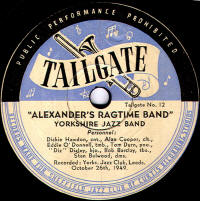 |
|
Talent |
Another post-WWII Sheffield jazz label, again making its
appearance in late 1949 and recorded by Curtis Studios in Sheffield. Talent records cost 7/6 and were available from
L. Corbridge at 19, Vauxhall Road, Sheffield 9 and also from the London
Jazz Club.
Thanks to Bill Dean-Myatt
for the label image. |
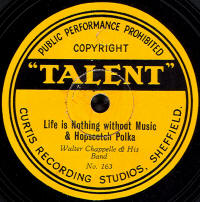 |
|
Talkie Cigarette Card |
The "Talkie" Cigarette Card Records were available in the first
half of 1934. These tiny records (2¾" square) were given free in the
packets of 20 Record Cigarettes. They were manufactured by Dubrico of
Slough, England, who were the successors to Durium, having bought the
company in January of that year.
Although thousands must have made
and distributed, they are pretty scarce these days, probably being
treated as ephemeral with most being lost or thrown away.
There were
5 different known series, all featuring well-known personalities of the
time, with each record stating there were 25 in each series.
The
five series are: Children's Hour, Film Stars, Sportsmen,The Stage and
Variety.
The extent of each series appears to be very optimistic as
the highest in any of the series is No. 9 of the sports personalities.
The reverse side had a brief biography of the personality and a line
drawing, along with the series number and an overall number for the set
(at the botton right of the image). The records have a 5000-series
matrix number, though many of the records don't show this at all.
My
example says it is issued by The Record Cigarette Company, but others
have the nake as The Record Tobacco Company.
Thanks to many years of
painstaking efforts by Steve Walker, I can present quite a reasonable
listing of these, which can be found on my
Durium page (click link in
left hand column). |
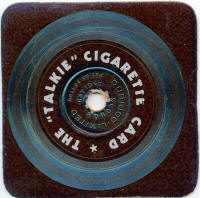
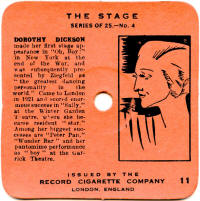 |
|
Teledisk |
Teledisk were
custom record makers, offering to record you for a small sum, for which
you would receive a small number of the recordings, double-sided and
pressed on standard shellac. To be honest, the quality of the recording
and pressing varied considerably and some are really dreadful. The
labels were either blue or red (as picture here) depending usually on
the type of fare being offered. The records date from 1934-35 and are,
as you'd expect, extremely rare. The company was at Crewdson Road,
London SW9.
|
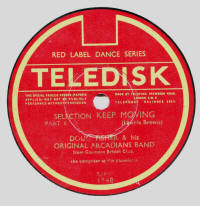 |
|
Telefunken |
Telefunken records first appeared in the early 1930s, I believe,
and were a German-only product as you could guess by the name. They do
turn up occasionally in Britian, since one or two companies imported
them. In the mid-1930s Keith Prowse, Rimington Van Wyck and Alfred Imhof
were amongst these.
The example here is from
the 1950's and is British made by Decca, who manufactured
Telefunken LPs at that period.
Thanks to Bill Dean-Myatt
for the label image. |
 |
|
Tempo
|
Tempo records first appeared in Setpember 1946 and issued both
new Jazz recordings and also vintage transfers. The new recordings had a
A- prefixed catalogue and the reissues an R- catalogue (both series
starting logically at 1). They were distributed by the Tempo Record
Society of 9, Piccadilly Arcade, London and available from specialist
dealers and jazz clubs. The initial issue of A-1 to A-44 cost 9/6, but
subsequent issues in both series were 7/6. |
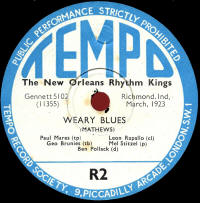 |
|
Theme Music |
This was a 1950s-60s label publishing library music for the Josef
Weinberger publishing house.
Thanks to Bill Dean-Myatt for the label image. |
 |
|
Times |
The three label styles shown here, are all from Manchester
and are likely to be the product of the same company. They appear to all
date from the early 1950s.
Thanks to Bill Dean-Myatt for the label images. |
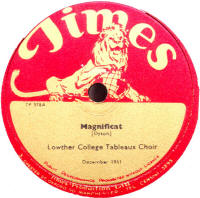


|
|
Times Record |
These were manufactured in England either by Decca or Pye
(probably the latter) for export to Kingston, Jamaica, where they were
sold in the Times Department Store. They date from the 1960s and early
1960s.
Thanks to Mike Murphy
for the information about this label. |
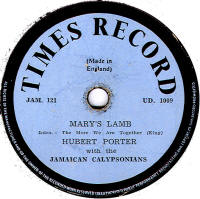 |
|
Tip-Top
|
This
label is found pasted over early Winner records. The Tip-Tops
probably date from the early 1920s and may have been used by a (so far)
unidentified shop as a way of selling off their old stock of Winner
records. What is surprising, though, it that they do have catalogue
numbers (not matching the original Winner ones) which implies the shop
may have actually produced a sales catalogue for Tip-Top!
Since there
is no copyright stamp, I can't estimate the price, though an example has
been seen where the original circular Edison Bell copyright stamp can be
seen under the Tip-Top label.
The details on the label are very
basic, just showing the title and a description of the recording.
Please
e-mail me with details of
ANY of these records.
Thanks to Bill Dean-Myatt for providing the label image. |
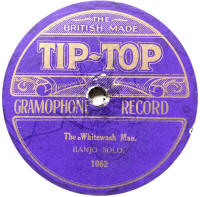 |
|
Tivoli |
A very anonymous looking label which gives no
clue as to the manufacturer or the proprietor. The label design is
almost identical to "Solitaire", so there must be a close connection.
Thanks to Bill Dean-Myatt for the label image. |
 |
Top Hits Of The Month
Record Club |
This record club dates from the mid-1950s. They issued cover
versions of 12 of the most popular songs (usually 6 on each rcord, three
on each side) every 6 weeks.
Fromt the catalogue numbering, it would
appear there was some link with the "Tivoli" record above.
Thanks to Bill Dean-Myatt for the label image. |
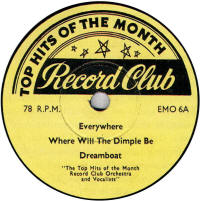 |
|
Topic |
This
label was owned by The Workers Music Association and the Topic records
were launched in the late 1930s with catalogue number TRC-1. The 78s were
issued spasmodically, in both 10" and 12" sizes (using the
same catalogue series) until the late 1950s by
which time they were being issued on 45rpm records.
The highest 78rpm record being TRC-108 issued
in 1958.
The recordings, with CP-prefixed matrix numbers, were done
by Decca using the contract pressing series started by Crystalate in the
late 1920s. Decca had taken over Crystalate in 1937.
A
listing of this label may be found here
Thanks to Bill Dean-Myatt for the label image. |
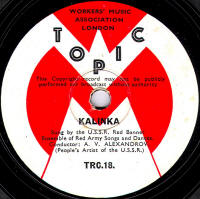 |
|
Top Rank |
Top Rank records, dating from the late 1950s,
was an attempt by the Rank Film Organisation to beak into the British
record business. These 78rpm records, pressed in vinyl had a catalogue
series starting at JAR-101 in 1958, but by 1960 the business failed and
the label was taken on by EMI and the 78rpm records dropped immediately.
I believe the 78rpm series reached JAR-432.
Thanks to Bill Dean-Myatt for the label image. |
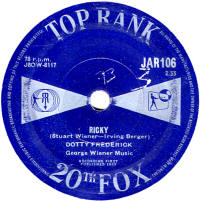 |
|
Tower
|
Dating from the early
1920s, Tower records was a Vocalion product, often using old masters
previous issued on Vocalion or one of their other subsidiary labels.
Masters also came from Gennett (in America) and the catalogue number was
in a 100-series (for 10") and 2000-series for 12".
Label listing: The late Arthur
Badrock's listing of this label is available from the
CLPGS.
(Reference Series No. RS 29) |
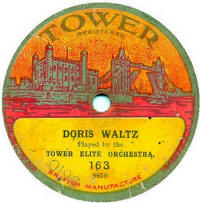 |
|
Towers Of London
|
This recording company seems to have started up during WWII;
they made transcription recordings for ENSA and maybe others, but it
would appear they also ran a record club, an example of which is shown
here.
Thanks to Robert Girling for
the label image. |
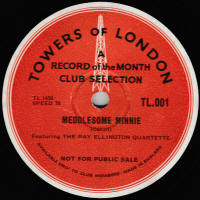 |
|
T.P.L. |
I've not managed to find out what TPL stood for,
but the company produced at least three talking books in 1948.
The trade distributors for the talking books
were Horace Marshall & Son Ltd., Temple House, Temple Avenue, London,
E.C.4. The book part was produced in France by Le Livre Universal and
was printed by Imprimerie Crété. A French “depot legal” (deposit for
copyrighting purposes) date of the third quarter of 1948 is given which
gives a rough date for the records. You will find an entry for Nicholas
Sandor (see the label image), a Hungarian engineer and inventor, under
www.gracesguide.co.uk
but this doesn’t shed any light on his connection with talking books. He
was an inventor and patented quite a number of his inventions and the
title page of the book states “Patent applied for” but it is difficult
to see just what was novel and hence patentable about a talking book.
I now have some details about three issues, see below. If there are
any more, do please let me know.
| Cat No |
Matrix |
Title |
Artists |
| SS-1 |
0EB-7-3
0EB-8-3 |
The Happy Prince
(Oscar Wilde), part 1
The Happy Prince (Oscar Wilde), part 2 |
Frank Phillips
(narrator), Leslie Bridgewater (music)
Adapted by Minnie Lake |
| SS-2 |
0EB-23
0EB-24 |
The Story Of The
First Christmas Morning, part 1
The Story Of The First Christmas Morning, part 2 |
Frank Phillips (narrator), Leslie Bridgewater (music)
Story
by Minnie Lake |
| SS-3 |
0EB-27-1
0EB-28-1 |
The Magic Wood
(Harry Phillips), part 1
The Magic Wood (Harry Phillips), part 2 |
Harry Phillips
(narrator & composer) |
Thanks to Bill Dean-Myatt for the label image,
to Dave Mason for providing the information about the label, and Paul
Buck for further issue details.
|
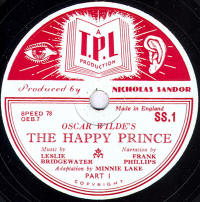 |
|
Transacord |
This company was started by Peter Handford
who was an experienced sound engineer & sound effects expert. In 1953,
with just a tape recorder & a 78rpm lacquer disc cutter, he offered
private recordings and also recordings of amatuer music events and
competitions. He would cut the records himself, from his tape recording,
unless more than 12 copies were required, in which case he would get
recprds pressed by British Homophone. In 1954, he heard an American LP
of railway sounds and decided to try something similar with British
railways. His first records in this style were issued in 1955 on 78rpm
discs. In 1958, after about half-a-dozen 78rpm issues (10" and 12"
sizes), Peter switched to the LP and 45rpm format.
Transacord was
later taken over by Argo Records and subsequently became part of Decca.
Thanks to Bill Dean-Myatt for the label image. |
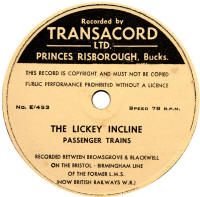 |
|
Transworld |
This appears to be a publisher's library
music outlet for Television Music Ltd. The records were made by C.H.
Rumble Ltd of Redhill, Surrey and date from 1961 to 1965. All were
pressed in vinyl and the catalogue series ran from TR-1 to TR-99.
Thanks to Bill Dean-Myatt for the label image. |
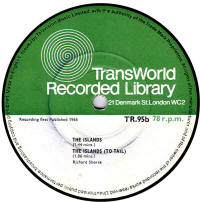 |
|
Treasury Of Music |
These records were made for EMG Hand Made Gramophones and were
first accounced in 1935.
These were 12" records priced at 6/-
each, and most likely were pressed from French masters, though it is not
known who made them.
The catalogue numbers started at T-1 and ran
to at leaast T-17. |
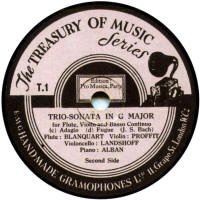 |
|
Trek |
These were recorded in South Africa by Eric
Gallo's Gramophone Records Ltd, and pressed by Decca in England, from
1940 until 1942, when shipping problems caused by WWII put an end to the
imports. After the war, in 196, Gallo resurrected the label much as
before but within a couple of years (in 1949) had built his own
presseing plant, thus no longer needing Decca's pressing services.
There were two atalogue series: AC-700- for Afrikaans material, and
DC-1- for other African music. These reached AC-820 and DC-47 by the
time of the war break. The post-war issues contiued with the same
series, eventually reaching AC-1046 and DC-399, though the last ones may
have been 45rpm issues.
Thanks to Bill Dean-Myatt for the label image. |
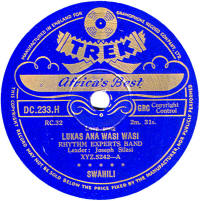 |
|
Triumph
|
The
first Triumph Record was manufactured in Germany, uning Invicta
(Berolina) masters. The catalogue numbers are the same as the Invicta
issues, but with 20 in front of the number, hence the one shown here,
Triumph 20342 is the same issue & coupling as Invicta 342. It is not
known who the Triumph records were produced for, but they will all
pre-date the outbreak of WWI in 1914, and most likely stopped well
before then. They are even scarcer than the Invicta issues, which are by
no means common themselves.
At some point in early 1914, most
likely after the German Triumphs had ceased, a British-made Triumph
Record was launched. These were made by the Disc Record Company at
Harrow, for Joseph Blum & Co, using original masters recorded by Blum.
The labels can be found in either dark blue or red, with gold printing.
Again these, like the German ones, were quite short-lived (and hence
scarce today) as both the Disc Record Company and Joseph Blum's company
went out of business in 1915.
Thanks to Bill Dean-Myatt for providing the label photos. |
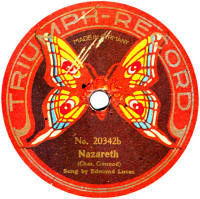
_small.JPG) |
|
Trusound |
One of the earliest flexible
picture discs, Trusound date from the early 1930s and are scarce
today, and even when they turn up, they are often unplayable. The
recordings are a mixture of continental masters and those recorded by
Trusound themselves.
The Trusound recording studio was in a former
church at 72a Carlton Hill, St. John's Wood, London, NW8 and up until
Trusound took it on in 1933, it had been the Parlophone recording
studio. The manager during Trusound's ownershop, was a Mr. Francis, who had been
a deputy of the Parlophone manager, Oscar Preuss. Trusound records cost
1/6. There seem to be about 50 different records, but in various
catalogue series such as T-1, A-600, A-1000 and B-500-. |
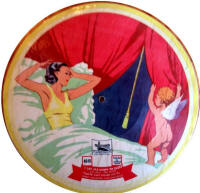 |
|
Tuck's Gramophone Record Postcard |
Raphael Tuck and his wife started producing graphic art printing in 1866
at their little business in London. Once their sons joined it became
Raphel Tuck & Sons and postcards were an important part of the business.
In about 1930 they joined forces with the Worldecho Record
Company to produce postcards with a tiny record affixed to the front,
which gave about a minute of playing time. |
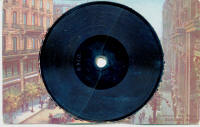
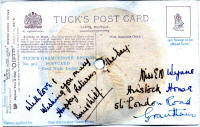 |
|
Turmaphon |
Turmaphon records were manufactured by the Turmalin factory in Germany
and the example shown here was specifically produced for export to
Britain. The few seen all have a U-series catalogue number, though a
couple have different numbers on each side, just to make things difficult
for 21st century discographers! All the issues shown here seem to be
using previously-recorded masters from the defunct Bel Canto company.
Thanks to
Michael
Gunrem for the label scan. |
_small.jpg) |
|
Twin |
When the Gramophone
Company decided to embark on producing double-sided records in 1908,
rather than risk their reputation on producing double-sided HMV records,
they decided to launch a new label called "Twin". Costing 2/6, the
records used existing single-sided Zonophone masters to start with,
until, in 1911, with the catalogue reaching about 600 (having started
from 1), the two were combined and the double-sided Zonophone-Twin label
became the Gramophone company's secondary label. Any which then remained
in the catalogue were re-pressed with Zonophone labels.
Label listing: the
CLPGS have
produced a full listing of the Twin & Zonophone label. |
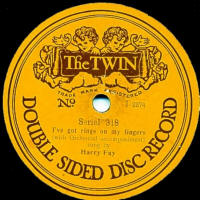 |
























_small.jpg)
